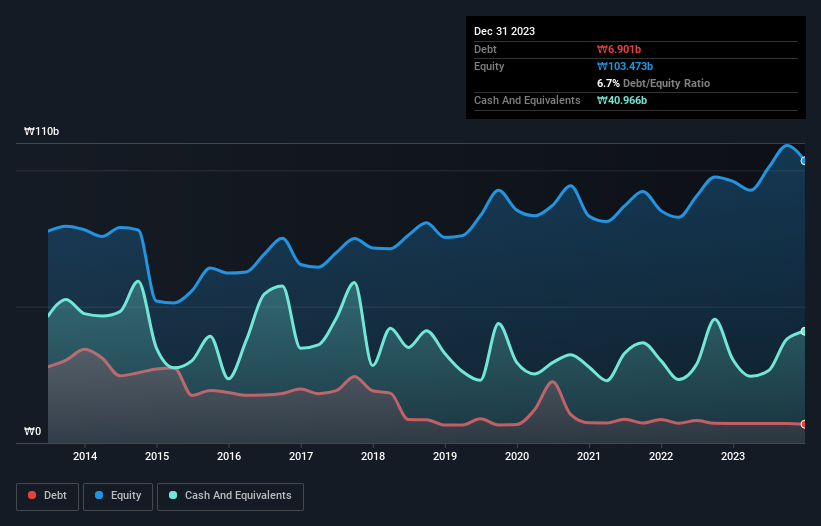- South Korea
- /
- Electric Utilities
- /
- KOSE:A130660
We Think Korea Electric Power Industrial Development (KRX:130660) Can Manage Its Debt With Ease
The external fund manager backed by Berkshire Hathaway's Charlie Munger, Li Lu, makes no bones about it when he says 'The biggest investment risk is not the volatility of prices, but whether you will suffer a permanent loss of capital.' So it might be obvious that you need to consider debt, when you think about how risky any given stock is, because too much debt can sink a company. We can see that Korea Electric Power Industrial Development Co., Ltd (KRX:130660) does use debt in its business. But is this debt a concern to shareholders?
What Risk Does Debt Bring?
Generally speaking, debt only becomes a real problem when a company can't easily pay it off, either by raising capital or with its own cash flow. Part and parcel of capitalism is the process of 'creative destruction' where failed businesses are mercilessly liquidated by their bankers. However, a more common (but still painful) scenario is that it has to raise new equity capital at a low price, thus permanently diluting shareholders. Of course, plenty of companies use debt to fund growth, without any negative consequences. The first step when considering a company's debt levels is to consider its cash and debt together.
See our latest analysis for Korea Electric Power Industrial Development
What Is Korea Electric Power Industrial Development's Net Debt?
The chart below, which you can click on for greater detail, shows that Korea Electric Power Industrial Development had ₩6.90b in debt in December 2023; about the same as the year before. But on the other hand it also has ₩41.0b in cash, leading to a ₩34.1b net cash position.

A Look At Korea Electric Power Industrial Development's Liabilities
We can see from the most recent balance sheet that Korea Electric Power Industrial Development had liabilities of ₩62.9b falling due within a year, and liabilities of ₩37.2b due beyond that. Offsetting this, it had ₩41.0b in cash and ₩43.1b in receivables that were due within 12 months. So it has liabilities totalling ₩16.1b more than its cash and near-term receivables, combined.
Given Korea Electric Power Industrial Development has a market capitalization of ₩252.7b, it's hard to believe these liabilities pose much threat. But there are sufficient liabilities that we would certainly recommend shareholders continue to monitor the balance sheet, going forward. While it does have liabilities worth noting, Korea Electric Power Industrial Development also has more cash than debt, so we're pretty confident it can manage its debt safely.
In addition to that, we're happy to report that Korea Electric Power Industrial Development has boosted its EBIT by 38%, thus reducing the spectre of future debt repayments. The balance sheet is clearly the area to focus on when you are analysing debt. But you can't view debt in total isolation; since Korea Electric Power Industrial Development will need earnings to service that debt. So if you're keen to discover more about its earnings, it might be worth checking out this graph of its long term earnings trend.
Finally, while the tax-man may adore accounting profits, lenders only accept cold hard cash. Korea Electric Power Industrial Development may have net cash on the balance sheet, but it is still interesting to look at how well the business converts its earnings before interest and tax (EBIT) to free cash flow, because that will influence both its need for, and its capacity to manage debt. Over the last three years, Korea Electric Power Industrial Development recorded free cash flow worth a fulsome 95% of its EBIT, which is stronger than we'd usually expect. That puts it in a very strong position to pay down debt.
Summing Up
While it is always sensible to look at a company's total liabilities, it is very reassuring that Korea Electric Power Industrial Development has ₩34.1b in net cash. And it impressed us with free cash flow of ₩27b, being 95% of its EBIT. So is Korea Electric Power Industrial Development's debt a risk? It doesn't seem so to us. The balance sheet is clearly the area to focus on when you are analysing debt. But ultimately, every company can contain risks that exist outside of the balance sheet. For example, we've discovered 2 warning signs for Korea Electric Power Industrial Development (1 is a bit unpleasant!) that you should be aware of before investing here.
At the end of the day, it's often better to focus on companies that are free from net debt. You can access our special list of such companies (all with a track record of profit growth). It's free.
Valuation is complex, but we're here to simplify it.
Discover if Korea Electric Power Industrial Development might be undervalued or overvalued with our detailed analysis, featuring fair value estimates, potential risks, dividends, insider trades, and its financial condition.
Access Free AnalysisHave feedback on this article? Concerned about the content? Get in touch with us directly. Alternatively, email editorial-team (at) simplywallst.com.
This article by Simply Wall St is general in nature. We provide commentary based on historical data and analyst forecasts only using an unbiased methodology and our articles are not intended to be financial advice. It does not constitute a recommendation to buy or sell any stock, and does not take account of your objectives, or your financial situation. We aim to bring you long-term focused analysis driven by fundamental data. Note that our analysis may not factor in the latest price-sensitive company announcements or qualitative material. Simply Wall St has no position in any stocks mentioned.
About KOSE:A130660
Korea Electric Power Industrial Development
Korea Electric Power Industrial Development Co., Ltd.
Flawless balance sheet and slightly overvalued.
Market Insights
Community Narratives




